Belkin F5D7234-4-H User Manual
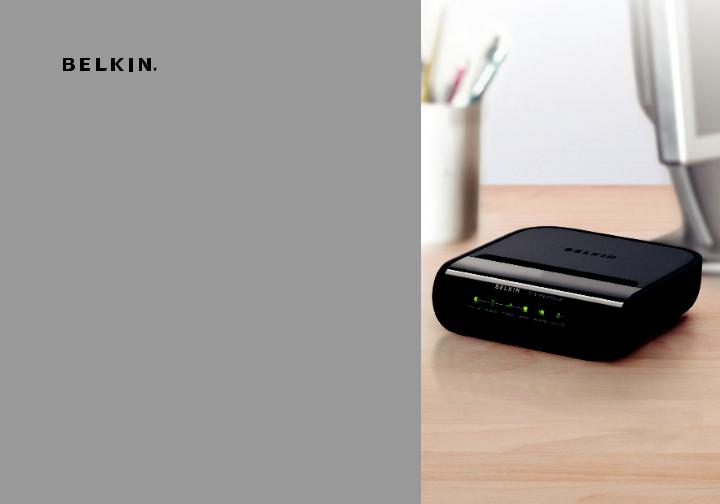
Wireless G
Router
User Manual
English
8820-00113ea F5D7234-4-H
Français
Deutsch
Nederlands
Español
Italiano

Table of Contents
Table of Contents |
sections |
1 |
2 |
3 |
4 |
5 |
6 |
7 |
8 |
9 |
10 |
1 Introduction 1
Benefits of a Home Network 1 Advantages of a Wireless Network 1 Placement of your Router for Optimal Performance 2
2 Product Overview |
5 |
Product Features 5
3 Knowing your Router 7
Package Contents 7 System Requirements 7 Setup Assistant Software System Requirements 7
Securing your Wi-Fi Network 49 WEP Setup 52 Using Wi-Fi Protected Setup 54 WPA Setup 55 Setting WPA/WPA2 56 Guest Access (Optional) 56
Using the Access Point Mode 59 Configuring the Firewall 60 Setting MAC Address Filtering 63 Enabling the DMZ 64 Utilities Tab 66
Restarting the Router 67 Updating the Firmware 70
7 Manually Configuring Network Settings 76
4 |
Connecting and Configuring your Router |
11 |
8 |
Recommended Web Browser Settings |
81 |
5 |
Alternate Setup Method |
25 |
9 |
Troubleshooting |
83 |
6 |
Using the Web-Based Advanced User Interface |
40 |
10 Information |
99 |
|
Changing LAN Settings 41
Viewing the DHCP Client List Page 43
Configuring the Wireless Network Settings 43
Wireless G Router |
i |

Introduction
Table of Contents |
sections |
1 |
2 |
3 |
4 |
5 |
6 |
7 |
8 |
9 |
10 |
Thank you for purchasing the Belkin Wireless G Router (the Router). The following two short sections discuss the benefits of home networking and outline best practices for maximizing your wireless home network range and performance. Please be sure to
read through this User Manual completely, and pay special attention to the section entitled “Placement of your Router for Optimal Performance” on page 2.
Benefits of a Home Network
•Share one high-speed Internet connection with all the computers in your home
•Share resources, such as files and hard drives among all the connected computers in your home
Advantages of a Wireless Network
•Mobility – you’ll no longer need a dedicated “computer room”—now you can work on a networked laptop or desktop computer anywhere within your wireless range
•Easy installation – The Belkin Setup Assistant software makes setup simple
•Flexibility – set up and access printers, computers, and other networking devices from anywhere in your home
•Share a single printer with the entire family
•Share documents, music, video, and digital pictures
•Store, retrieve, and copy files from one computer to another
•Simultaneously play games online, check Internet email, and chat
•Easy expansion – the wide range of Belkin networking products lets you expand your network to include devices such as printers and gaming consoles
•No cabling required – you can spare the expense and hassle of retrofitting Ethernet cabling throughout the home or office
•Widespread industry acceptance – choose from a wide range of interoperable networking products
Wireless G Router |
1 |

Introduction
Table of Contents |
sections |
1 |
2 |
3 |
4 |
5 |
6 |
7 |
8 |
9 |
10 |
Placement of your Router for Optimal Performance
Important Factors for Placement and Setup
Your wireless connection will be stronger the closer your computer is to your Router. Typical indoor operating range for wireless devices is between 100 and 200 feet.
In the same way, your wireless connection and performance will degrade somewhat as the distance between your Router and connected devices increases. This may or may not be noticeable to you. As you move farther from your Router, connection speed may decrease. Factors that can weaken signals simply by getting in the way of your network’s radio waves are metal appliances or obstructions, and walls.
If you have concerns about your network’s performance that might be related to range or obstruction factors, try moving the computer to a position between five and 10 feet away from the Router in order to see if distance is the problem. If difficulties persist even at close range, please contact Belkin Technical Support.
Note: While some of the items listed below can affect network performance, they will not prohibit your wireless network from functioning; if you are concerned that your network is not operating at its maximum effectiveness, this checklist may help.
•Ensure that your Router’s networking antennas are parallel to each other, and are positioned vertically (toward the ceiling). If your Router itself is positioned vertically, point the antennas as much as possible in an upward direction.
•In multistory homes, place the Router on a floor that is as close to the center of the home as possible. This may mean placing the Router on an upper floor.
•Try not to place the Router near a cordless phone.
2. Avoid Obstacles and Interference
Avoid placing your Router near devices that may emit radio “noise,” such as microwave ovens. Dense objects that can inhibit wireless communication include:
•Refrigerators
•Washers and/or dryers
•Metal cabinets
1. Wireless Router Placement
Place your Router, the central connection point of your network, as close as possible to the center of your wireless network devices.
To achieve the best wireless network coverage for your “wireless clients” (i.e., computers enabled by Belkin Wireless Notebook Network Cards, Wireless Desktop Network Cards, and Wireless USB Adapters):
•Large aquariums
•Metallic-based, UV-tinted windows
If your wireless signal seems weak in some spots, make sure that objects such as these are not blocking the signal’s path (between your computers and Router).
Wireless G Router |
2 |

Introduction
Table of Contents |
sections |
1 |
2 |
3 |
4 |
5 |
6 |
7 |
8 |
9 |
10 |
3. Cordless Phones
If the performance of your wireless network is impaired after attending to the above issues, and you have a cordless phone:
•Try moving cordless phones away from the Router and your wireless-enabled computers.
•Unplug and remove the battery from any cordless phone that operates on the 2.4GHz band (check the manufacturer’s information). If this fixes the problem, your phone may
be interfering.
•If your phone supports channel selection, change the channel on the phone to the farthest channel from your wireless network. For example, change the phone to channel 1 and move your Router to channel 11. See your phone’s user manual for detailed instructions.
•If necessary, consider switching to a 900MHz cordless phone.
4. Choose the “Quietest” Channel for your Wireless Network
In locations where homes or offices are close together, such as apartment buildings or office complexes, there may be wireless networks nearby that can conflict with yours.
Use the Site Survey capabilities found in the wireless utility of your wireless adapter or card to locate any other wireless networks that are available (see your wireless adapter’s or card’s user manual), and move your Router and computers to a channel as far away from other networks as possible.
•Experiment with more than one of the available channels in order to find the clearest connection and avoid interference from neighboring cordless phones or other wireless devices.
•For Belkin wireless networking products, use the detailed Site Survey and wireless channel information included with your Wireless Network Card or Adapter. See your Network Card’s user guide for more information.
These guidelines should allow you to cover the maximum possible area with your Router. Should you need to cover an even wider area, we suggest the Belkin Wireless G Universal Range Extender/Access Point.
Wireless G Router |
3 |

Introduction
Table of Contents |
sections |
1 |
2 |
3 |
4 |
5 |
6 |
7 |
8 |
9 |
10 |
5. Secure Connections, VPNs, and AOL
Secure connections typically require a user name and password, and are used where security is important. Secure connections include:
•Virtual Private Network (VPN) connections, often used to connect remotely to an office network
•The “Bring Your Own Access” program from America Online (AOL), which lets you use AOL through broadband provided by another cable or DSL service
•Most online banking websites
•Many commercial websites that require a user name and password to access your account
Secure connections can be interrupted by a computer’s power management setting, which causes it to “go to sleep.” The easiest solution to avoid this is to simply reconnect by rerunning the VPN or AOL software, or by re-logging into the secure website.
A second alternative is to change your computer’s power management settings so it does not go to sleep; however, this may not be appropriate for portable computers. To change your power management setting under Windows, see the “Power Options” item in the Control Panel.
If you continue to have difficulty with secure connections, VPNs, and AOL, please review the steps above to be sure you have addressed these issues.
For more information regarding our networking products, visit our website at www.belkin.com/networking.
Wireless G Router |
4 |

Product Overview
Table of Contents |
sections |
1 |
2 |
3 |
4 |
5 |
6 |
7 |
8 |
9 |
10 |
Product Features
In minutes you will be able to share your Internet connection and network your computers. The following is a list of features that make your new Belkin Wireless G Router an ideal solution for your home or small office network.
Works with Both PCs and Mac® Computers
The Router supports a variety of networking environments including Mac OS® X, Linux®, Windows® 2000, XP, Vista®, and others. All that is needed is an Internet browser and a network adapter that supports TCP/IP (the standard language of the Internet).
Patent-Pending Network Status Display
Lighted LEDs on the front of the Router indicate which functions are in operation. You’ll know at a glance whether your Router is connected to the Internet. This feature eliminates the need for advanced software and status-monitoring procedures.
Web-Based Advanced User Interface
You can set up the Router’s advanced functions easily through your web browser, without having to install additional software onto the computer. There are no disks to install or keep track of and, best of all, you can make changes and perform setup functions from any computer on the network quickly and easily.
NAT IP Address Sharing
Your Router employs Network Address Translation (NAT) to share the single IP address assigned to you by your Internet Service Provider while saving the cost of adding IP addresses to your Internet service account.
SPI Firewall
Your Router is equipped with a firewall that will protect your network from a wide array of common hacker attacks including IP Spoofing, Land Attack, Ping of Death (PoD), Denial of Service (DoS), IP with zero length, Smurf Attack, TCP Null Scan, SYN flood, UDP flooding, Tear Drop Attack, ICMP defect, RIP defect, and fragment flooding.
Integrated 10/100 4-Port Switch
The Router has a built-in, 4-port network switch to allow your wired computers to share printers, data and MP3 files, digital photos, and much more. The switch features automatic detection so it will adjust to the speed of connected devices. The switch will transfer data between computers and the Internet simultaneously without interrupting or consuming resources.
Universal Plug-and-Play (UPnP) Compatibility
UPnP (Universal Plug-and-Play) is a technology that offers seamless operation of voice messaging, video messaging, games, and other applications that are UPnP-compliant.
Wireless G Router |
5 |

Product Overview
Table of Contents |
sections |
1 |
2 |
3 |
4 |
5 |
6 |
7 |
8 |
9 |
10 |
Support for VPN Pass-Through
If you connect to your office network from home using a VPN connection, your Router will allow your VPN-equipped computer to pass through the Router and to your office network.
Built-In Dynamic Host Configuration Protocol (DHCP)
Built-In Dynamic Host Configuration Protocol (DHCP) on-board makes for the easiest possible connection of a network. The DHCP server will assign IP addresses to each computer automatically so there is no need for a complicated networking setup.
Setup Assistant Software
The Setup Assistant Software takes the guesswork out of setting up your Router. This automatic software determines your network settings for you and sets up the Router for connection to your Internet Service Provider (ISP). In a matter of minutes, your Wireless Router will be up and running on the Internet.
NOTE: Setup Assistant Software is compatible with Windows 2000, XP, Vista, and Mac OS X. If you are using another operating system, the Wireless Router can be set up using the Alternate Setup Method described in this User Manual (see page 25).
Integrated 802.11g Wireless Access Point
802.11g is an exciting new wireless technology that achieves data rates up to 54Mbps, nearly five times faster than 802.11b.
MAC Address Filtering
For added security, you can set up a list of MAC addresses (unique client identifiers) that are allowed access to your network. Every computer has its own MAC address. Simply enter these MAC addresses into a list using the Web-Based Advanced User Interface and you can control access to your network.
Wireless G Router |
6 |

Knowing your Router
Table of Contents |
sections |
1 |
2 |
3 |
4 |
5 |
6 |
7 |
8 |
9 |
10 |
Package Contents
•Belkin G Wireless Router
•Quick Installation Guide
•Belkin Setup Assistant Software CD with User Manual
•Belkin RJ45 Ethernet Networking Cable
•Power Supply
System Requirements
•Broadband Internet connection such as a cable or DSL modem with RJ45 (Ethernet) connection
•At least one computer with an installed network interface adapter
•TCP/IP networking protocol installed on each computer
•RJ45 Ethernet networking cable
•Internet browser
Setup Assistant Software System Requirements
•A computer running Windows 2000, XP, or Vista, or Mac OS X v10.x
•Minimum 1GHz processor and 128MB RAM
•Internet browser
The Router has been designed to be placed on a desktop. All of the cables exit from the rear of the Router for better organization and utility. The Network Status Display is easily visible on the FRONT of the Router to provide you with information about network activity and status.
(A) (B) (C) (D) (E) (F) (G)
Wireless G Router |
7 |

Knowing your Router
Table of Contents |
sections |
1 |
2 |
3 |
4 |
5 |
6 |
7 |
8 |
9 |
10 |
A. Internet Status
This unique icon shows you when the Router is connected to the Internet. When the light is off, the Router is NOT connected to the Internet. When the light is blinking amber, the Router is attempting to connect to the Internet. When the light is solid blue, the Router is
connected to the Internet. When using the “Disconnect after x minutes” feature, this icon becomes extremely useful in monitoring the status of your Router’s connection.
Off |
Router is NOT connected to |
|
the Internet |
||
|
||
|
|
|
Blinking Green |
Router is attempting to connect |
|
to the Internet |
||
|
||
|
|
|
Solid Green |
Router is connected to |
|
the Internet |
||
|
||
|
|
B. Modem Status
This icon lights in blue to indicate that your modem is connected properly to the Router. It turns amber when problem is detected.
Off |
Router is NOT connected to |
|
modem |
||
|
||
|
|
|
Blinking Green |
Router is connecting to the ISP |
|
|
|
|
Solid Green |
Router is connected to modem |
|
and functioning properly |
||
|
||
|
|
C. Router/Power Status
When you apply power to the Router or restart it, a short period of time elapses while the Router boots up. During this time, the “router” icon blinks. When the Router has completely booted up, the “router” icon becomes a solid light, indicating the Router is ready for use.
Off |
Router is off |
|
|
|
|
Blinking Green |
Router is booting up |
|
|
|
|
Solid Green |
Router is on and ready |
|
|
|
|
D. Wired-Computer Status |
|
|
|
|
|
Off |
Wired computer is not present |
|
|
|
|
Solid Green |
Wired computer is connected to |
|
the Router |
||
|
||
|
|
|
Blinking Green |
Data is transmitting between the |
|
Router and wired computer(s) |
||
|
||
|
|
Wireless G Router |
8 |

Knowing your Router
Table of Contents |
sections |
1 |
2 |
3 |
4 |
5 |
6 |
7 |
8 |
9 |
10 |
E. Wireless-Computer Status
Off |
Wireless computer is not present |
|
|
|
|
Solid Green |
Wireless computer is connected |
|
to the Router |
||
|
||
|
|
|
Blinking Green |
Data is transmitting between the |
|
Router and wireless computer(s) |
||
|
||
|
|
G. Wi-Fi Protected Setup (WPS) button
This button is used for the Wi-Fi Protected Setup™ feature. Please refer to the “Changing the Wireless Security Settings” section.
F. Wireless Security
Off |
Wireless security is off |
|
|
Solid Green |
Wireless security is on |
|
|
Blinking Green |
WPS sync in progress |
|
|
Wireless G Router |
9 |

Knowing your Router
Table of Contents |
sections |
1 |
2 |
3 |
4 |
5 |
6 |
|
|
7 |
|
|
8 |
9 |
10 |
|||||||
H. Connection to Modem – Yellow |
|
|
|
|
|
|
|
|
|
|
|
|
|
|
|
|
|
|
|
|
|
|
This port is for connection to your cable or DSL modem. Use the cable that |
|
|
|
|
|
|
|
|
|
|
|
|
|
|
|
|
|
|
||||
was provided with the Router to connect the modem to this port. Use of a |
|
|
|
|
|
|
|
|
|
|
|
|
|
|
||||||||
|
|
(H) |
|
(I) |
|
(J) |
(K) |
|
||||||||||||||
cable other than the cable supplied with the Router may not work properly. |
|
|
|
|
|
|
|
|
|
|
|
|
|
|
|
|
|
|
||||
I. Connections to Computers – Gray |
|
|
|
|
|
|
|
|
|
|
|
|
|
|
|
|
|
|
|
|
|
|
Connect your wired (non-wireless) computers to these ports. These ports |
|
|
|
|
|
|
|
|
|
|
|
|
|
|
|
|
|
|
||||
|
|
|
|
|
|
|
|
|
|
|
|
|
|
|
|
|
|
|||||
are RJ45, 10/100 auto-negotiation, auto-uplinking ports for standard UTP |
|
|
|
|
|
|
|
|
|
|
|
|
|
|
|
|
|
|
||||
category 5 or 6 Ethernet cable. The ports are labeled 1 through 4. |
|
|
|
|
|
|
|
|
|
|
|
|
|
|
|
|
|
|
|
|||
J. Power Jack |
|
|
|
|
|
|
|
|
|
|
|
|
|
|
|
|
|
|
|
|
|
|
|
|
|
|
|
|
|
|
|
|
|
|
|
|
|
|
|
|
|
|
|
|
|
|
|
|
|
|
|
|
|
|
|
|
|
|
|
|
|
|
|
|
|
|
|
|
Connect the included 9V/1A DC power supply to this jack. |
|
|
|
|
|
|
|
|
|
|
|
|
|
|
|
|
|
|
|
|||
|
|
|
|
|
|
|
|
|
|
|
|
|
|
|
|
|
|
|
||||
K. Reset Button |
|
|
|
|
|
|
|
|
|
|
|
|
|
|
|
|
|
|
|
|
|
|
The “Reset” button is used in rare cases when the Router may function |
|
|
|
|
|
|
|
|
|
|
|
|
|
|
|
|
|
|
||||
improperly. Resetting the Router will restore the Router’s normal operation |
|
|
|
|
|
|
|
|
|
|
|
|
|
|
|
|
|
|
||||
while maintaining the programmed settings. You can also restore the factory |
|
|
|
|
|
|
|
|
|
|
|
|
|
|
|
|
|
|
||||
default settings by using the “Reset” button. Use the restore option in |
|
|
|
|
|
|
|
|
|
|
|
|
|
|
|
|
|
|
||||
instances where you may have forgotten your login password. |
|
|
|
|
|
|
|
|
|
|
|
|
|
|
|
|
|
|
|
|||
a. Resetting the Router |
|
|
|
|
|
|
|
|
|
|
|
|
|
|
|
|
|
|
|
|
|
|
Push and release the “Reset” button. The lights on the Router will |
|
|
|
|
|
|
|
|
|
|
|
|
|
|
|
|
|
|
||||
momentarily flash. The “router” light will begin to blink. When the |
|
|
|
|
|
|
|
|
|
|
|
|
|
|
|
|
|
|
||||
“router” light becomes solid again, the reset is complete. |
|
|
|
|
|
|
|
|
|
|
|
|
|
|
|
|
|
|
|
|||
b. Restoring the Factory Defaults |
|
|
|
|
|
|
|
|
|
|
|
|
|
|
|
|
|
|
|
|
|
|
Press and hold the “Reset” button for at least 10 seconds, then release it. |
|
|
|
|
|
|
|
|
|
|
|
|
|
|
|
|
|
|
||||
The lights on the Router will momentarily flash. The “router” light will begin |
|
|
|
|
|
|
|
|
|
|
|
|
|
|
|
|
|
|
||||
to blink. When the “router” light becomes solid again, the reset is complete. |
|
|
|
|
|
|
|
|
|
|
|
|
|
|
|
|
|
|
||||
Wireless G Router |
10 |

Connecting and Configuring your Router
Table of Contents |
sections |
1 |
2 |
3 |
4 |
5 |
6 |
7 |
8 |
9 |
10 |
Verify the contents of your box. You should have the following:
•Belkin G Wireless Router
•Quick Installation Guide
•Belkin Setup Assistant Software CD with User Manual
•RJ45 Ethernet Networking Cable (for connection of the Router to the modem)
•Power Supply
Modem Requirements
Your cable or DSL modem must be equipped with an RJ45 Ethernet port. Many modems have both an RJ45 Ethernet port and a USB connection. If you have a modem with both Ethernet and USB, and are using the USB connection at this time, you will be instructed to use the RJ45 Ethernet port during the installation procedure. If your modem has only a USB port, you can request a different type of modem from your ISP, or you can, in some cases, purchase a modem that has an RJ45 Ethernet port on it.
ALWAYS INSTALL YOUR ROUTER FIRST! IF YOU ARE INSTALLING NUMEROUS NETWORK DEVICES FOR THE FIRST TIME, IT IS IMPORTANT THAT YOUR ROUTER IS CONNECTED AND RUNNING BEFORE ATTEMPTING TO INSTALL OTHER NETWORK COMPONENTS SUCH AS NOTEBOOK CARDS AND DESKTOP CARDS.
Setup Assistant
Belkin has provided our Setup Assistant software to make installing your Router a simple and easy task. You can use it to get your Router up and running in minutes. The Setup Assistant requires that your Windows 2000/XP, Vista, or Mac OS X v10.4 or v10.5 computer be connected directly to your cable or DSL modem and that the Internet connection is active and working at the time of installation. If it is not, you must use the “Alternate Setup Method” section of this User Manual to configure your Router. Additionally, if you are using an operating system other than Windows 2000/XP, Vista, or Mac OS X v10.4 or v10.5, you must set up the Router using the “Alternate Setup Method” section of this User Manual.
Wireless G Router |
11 |
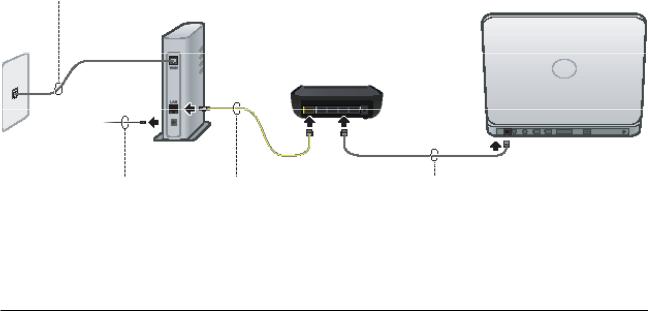
Connecting and Configuring your Router
Table of Contents |
sections |
1 |
2 |
3 |
4 |
5 |
6 |
7 |
8 |
9 |
10 |
[1]Make sure your DSL or cable line is plugged into your modem.
Put the Router next to your DSL or cable modem.
[2]Remove the power cord from your DSL or cable modem.
Connect the modem to the Router’s “modem” port with an Ethernet cable. (Your computer might be plugged into the modem already.)
Connect your computer to the Router with another Ethernet cable (temporarily, if need be).
Wireless G Router |
12 |
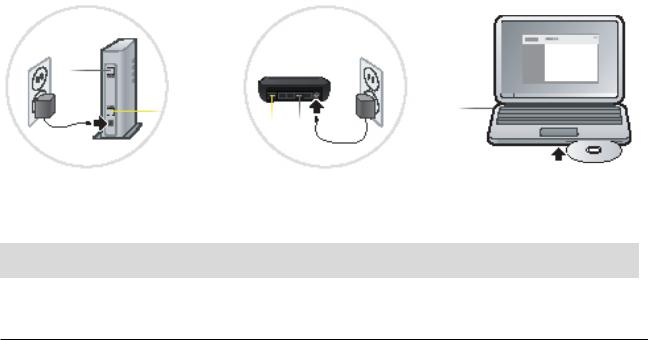
Connecting and Configuring your Router
Table of Contents |
sections |
1 |
2 |
3 |
4 |
5 |
6 |
7 |
8 |
9 |
10 |
[3]Plug in your modem and make sure it turns on. If your modem is already on, unplug it, wait a few seconds, and plug it back in.
Plug the Router’s power supply into the Router and a power outlet.
Put the CD into your computer. If the Setup Assistant doesn’t run automatically, browse the CD, find the Setup Assistant icon, and run it.
IMPORTANT: Run the Setup Assistant from the computer that is directly connected to the Router from Step 2.
Wireless G Router |
13 |
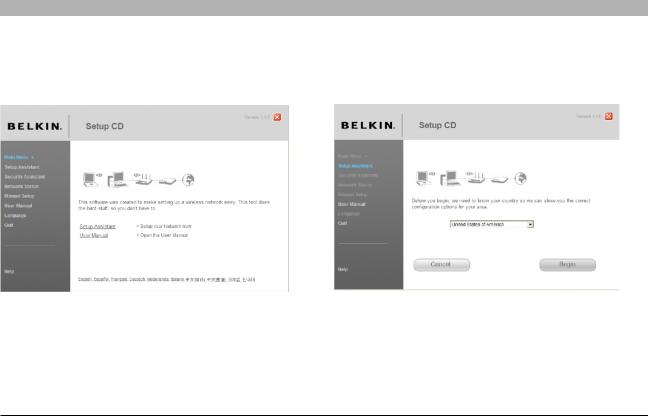
Connecting and Configuring your Router
Table of Contents |
sections |
1 |
2 |
3 |
Note for Windows Users: If the Setup Assistant does not start up automatically, select your CD-ROM drive from “My Computer” and double-click on the file named “SetupAssistant” to start the Setup Assistant.
4 |
5 |
6 |
7 |
8 |
9 |
10 |
Select Country
Select your country from the drop-down box. Click “Begin” to continue.
Wireless G Router |
14 |
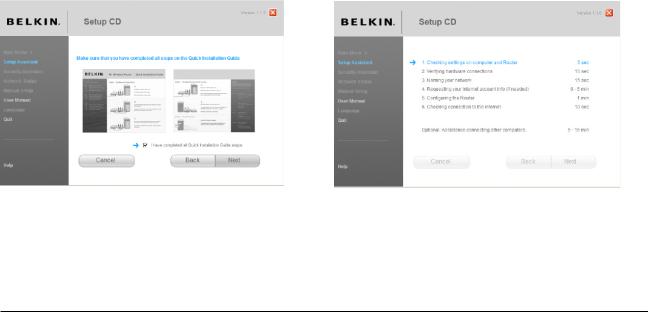
Connecting and Configuring your Router
Table of Contents |
sections |
1 |
2 |
3 |
4 |
5 |
6 |
7 |
8 |
9 |
10 |
Confirmation Screen |
|
|
|
|
|
Progress |
Screen |
|
|
|
|
Verify that you have completed all QIG steps by checking the box to the right of the arrow. Click “Next” to continue.
Setup Assistant will show you a progress screen each time a step in the setup has been completed.
Wireless G Router |
15 |
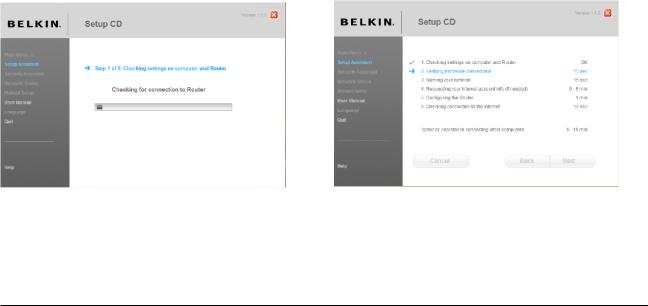
Connecting and Configuring your Router
Table of Contents |
sections |
1 |
2 |
3 |
4 |
5 |
6 |
7 |
8 |
9 |
10 |
2.1 Checking Settings |
|
|
|
|
2.2 Verifying Hardware Connections |
|
|
|
|||
The Setup Assistant will now examine your computer’s network settings |
|
The Setup Assistant will now verify your hardware connection. |
|
||||||||
and gather information needed to complete the Router’s connection to |
|
|
|
|
|
|
|
||||
the Internet. |
|
|
|
|
|
|
|
|
|
|
|
Wireless G Router |
16 |

Connecting and Configuring your Router
Table of Contents |
sections |
1 |
2 |
3 |
4 |
5 |
6 |
7 |
8 |
9 |
10 |
2.3 Naming your Wireless Network
The Setup Assistant will display the default wireless network name or Service Set Identifier (SSID). This is the name of your wireless network to which your computers or devices with wireless network adapters will connect. You can either use the default or change it to something unique. Write down this name for future reference.
2.4 Requesting Internet Account Info (if needed)
Select your ISP from the drop-down boxes.
Wireless G Router |
17 |
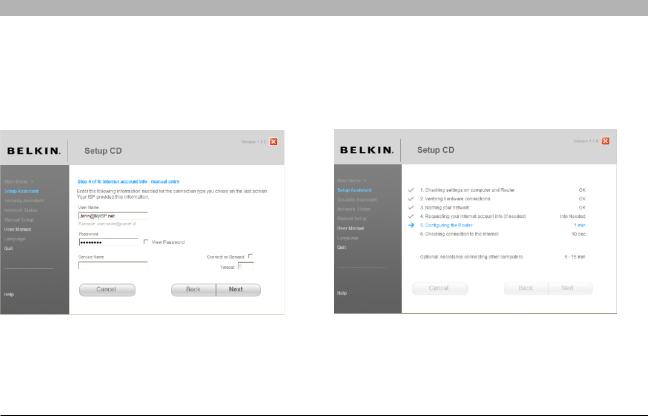
Connecting and Configuring your Router
Table of Contents |
sections |
1 |
2 |
3 |
If your Internet account requires a login and password, you will be prompted with a screen similar to the illustration below. Click “Next” to continue.
4 |
5 |
6 |
7 |
8 |
9 |
10 |
2.5 Configuring the Router
The Setup Assistant will now configure your Router by sending data to the Router and restarting it. Wait for the on-screen instructions.
Note: Do not disconnect any cable or power off the Router while the Router is rebooting. Doing so will render your Router inoperable.
Wireless G Router |
18 |

Connecting and Configuring your Router
Table of Contents |
sections |
1 |
2 |
3 |
4 |
5 |
6 |
7 |
8 |
9 |
10 |
2.6 Checking Internet Connection |
|
|
|
|
Congratulations |
|
|
|
|
|
|
We are almost done. The Setup Assistant will now check your connection to the Internet.
You have finished installing your new Belkin Router. You will see the Congratulations screen when your Router can connect to the
Internet. You can begin surfing by opening your browser and going to any website.
You can use the Setup Assistant to set up your other wired and wireless computers to connect to the Internet by clicking “Next”. If you decide to add computers to your Router later, select “Finish—return to Main Menu” and then click “Next”.
Wireless G Router |
19 |

Connecting and Configuring your Router
Table of Contents |
sections |
1 |
2 |
3 |
4 |
5 |
6 |
7 |
8 |
9 |
10 |
Troubleshooting
If the Setup Assistant is not able to connect to the Internet, you will see the following screen. Follow the on-screen instructions to go through the troubleshooting steps.
2.7 Optional: Assistance Connecting Other Computers
This optional step will help you to connect additional wired and wireless computers to your network. Follow the on-screen instructions.
Wireless G Router |
20 |
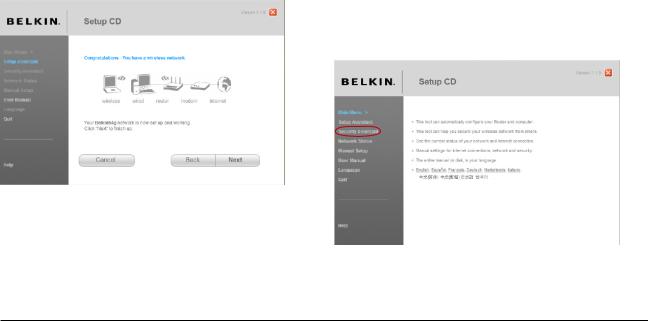
Connecting and Configuring your Router
Table of Contents |
sections |
1 |
2 |
3 |
4 |
5 |
6 |
7 |
8 |
9 |
10 |
Once you have verified that your other wired and wireless computers are properly connected, your network is set up and working. You can now surf the Internet. Click “Next” to return to the main menu.
Step 3: Set Up Wireless Security – Run the Security Assistant Software
Now that your network is set up and working, it is recommended that you turn on wireless security to prevent unauthorized access to your network from neighboring wireless-enabled computers. The Security Assistant will guide you through the process. Click “Security Assistant” and follow the on-screen instructions.
IMPORTANT: Run the Setup Assistant from the computer that is directly connected to the Router.
Wireless G Router |
21 |

Connecting and Configuring your Router
Table of Contents |
sections |
1 |
2 |
3 |
4 |
5 |
6 |
7 |
8 |
9 |
10 |
Progress Screen |
|
|
|
|
|
3.1 Picking the Security Type |
|
|
|
|
|
The Security Assistant will show you a progress screen each time a step has been completed.
Select the security type for your wireless network and click “Next” to continue.
Wireless G Router |
22 |

Connecting and Configuring your Router
Table of Contents |
sections |
1 |
2 |
3 |
4 |
5 |
6 |
7 |
8 |
9 |
10 |
3.2 Creating a Network Key |
|
|
|
|
3.3 Transferring the Key |
|
|
|
|
||
Enter a network key (PSK) for your wireless network and click “Next” to continue.
After setting up your wireless security, you will have to transfer the network key to each of your wireless computers. Click on “Transfer Key” if you have a USB flash drive. Follow the on-screen instructions, or click on “Print” to print the information. Manually enter it to each wireless computer. Then, click “Next” to continue.
Wireless G Router |
23 |
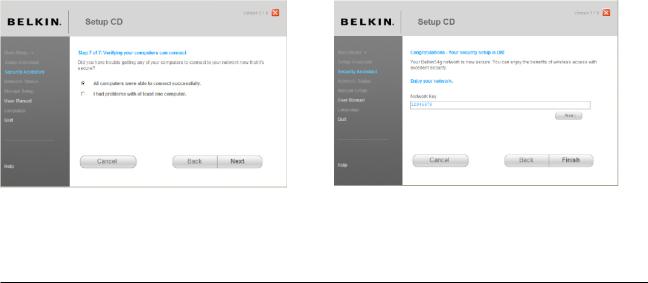
Connecting and Configuring your Router
Table of Contents |
sections |
1 |
2 |
3 |
4 |
5 |
6 |
7 |
8 |
9 |
10 |
3.4 Verifying the Connection |
|
|
|
|
Congratulations |
|
|
|
|
|
|
If all your wireless computers are able to connect to the Router, click “Next”. If you are having trouble, select “I had problem with at least one computer” and click “Next”. Then, follow on-screen instructions.
Once you have verified that your wireless computers are properly connected, your wireless network is set up and secured. You now can run your network wirelessly and securely. Click “Finish” to take you back to the main menu.
Wireless G Router |
24 |

Alternate Setup Method
Table of Contents |
sections |
1 |
2 |
3 |
4 |
5 |
6 |
7 |
8 |
9 |
10 |
The Web-Based Advanced User Interface is a web-based tool that you can use to set up the Router if you don’t want to use the Setup Assistant Software. You can also use it to manage advanced functions of the Router. From the Web-Based Advanced User Interface, you can perform the following tasks:
• |
View the Router’s current settings and status |
• |
Enable the DMZ feature for a single computer on your network |
• |
Configure the Router to connect to your ISP with the settings that |
• |
Change the Router’s internal password |
|
they provided you |
• |
Enable/Disable UPnP (Universal Plug-and-Play) |
|
|
•Change the current network settings such as the Internal IP
|
address, the IP address pool, DHCP settings, and more |
• |
Reset the Router |
• |
Set the Router’s firewall to work with specific applications |
• |
Back up your configuration settings |
|
(port forwarding) |
• |
Reset the Router’s default settings |
|
|
•Set up security features such as client restrictions, MAC address
filtering, WEP, and WPA |
• |
Update the Router’s firmware |
Wireless G Router |
25 |

Alternate Setup Method
Table of Contents |
sections |
1 |
2 |
3 |
4 |
5 |
6 |
7 |
8 |
9 |
10 |
Step 1 Set up your Computer’s Network Settings to Work with a DHCP Server
See the section in this User Manual called “Manually Configuring Network Settings” for directions.
Step 2 Configure the Router Using the Web-Based Advanced User Interface
Using your Internet browser, you can access the Router’s Web-Based Advanced User Interface. In your browser, type “192.168.2.1” (you do not need to type in anything else such as “http://” or “www”). Then press the “Enter” key.
PLEASE NOTE: If you have difficulty accessing the Router’s Web-Based Advanced User Interface, go to the section entitled “Manually Configuring Network Settings”.
Wireless G Router |
26 |

Alternate Setup Method
Table of Contents |
sections |
1 |
2 |
3 |
4 |
5 |
6 |
7 |
8 |
9 |
10 |
Logging into the Router |
|
|
|
|
Logging out of the Router |
|
|
|
|
||
You will see the Router’s home page in your browser window. The home page is visible to any user who wants to see it. To make any changes to the Router’s settings, you have to log in. Clicking the “Login” button or clicking on any one of the links on the home page will take you to the login screen. The Router ships with no password entered. In the login screen, leave the password blank and click the “Submit” button to log in.
One computer at a time can log into the Router for the purposes of making changes to the settings of the Router. Once a user has logged in to make changes, there are two ways that the computer can be logged out. Clicking the “Logout” button will log the computer out. The second method is automatic. The login will time out after a specified period of time. The default login time-out is 10 minutes. This can be changed from 1 to 99 minutes. For more information, see the section in this manual entitled “Changing the Login Time-Out Setting”.
Wireless G Router |
27 |
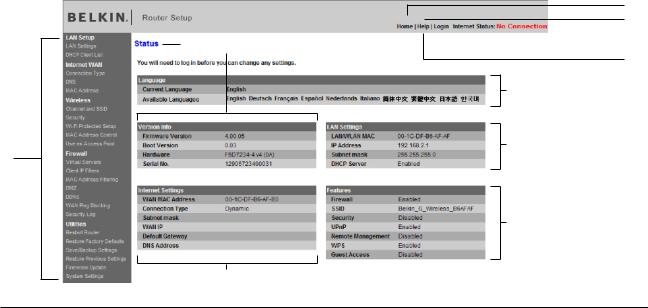
Alternate Setup Method
Table of Contents |
sections |
1 |
2 |
3 |
4 |
5 |
6 |
7 |
8 |
9 |
10 |
Using the Web-Based Advanced User Interface
The home page is the first page you will see when you access the Web-Based Advanced User Interface (UI). The home page shows you a quick view of the Router’s status and settings. All advanced setup pages can be reached from this page.
(2)
(3)
(11) |
(10) |
|
(4) |
|
(5)
(6)
(7)
(1)
(8)
(9)
Wireless G Router |
28 |
